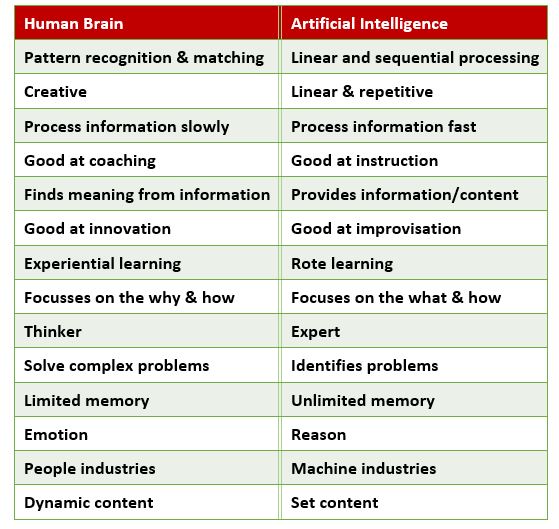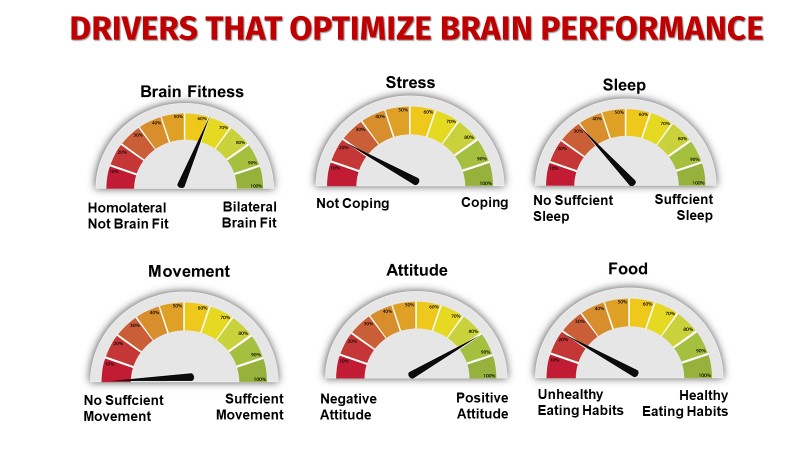By Dr. André Vermeulen, International Expert in the Neuroscience of Learning and Consultant to Full Potential Group
Up to 30% of UK jobs could be at strong risk of automation by the early 2030s according to PwC, while a recent Royal Society of Arts (RSA) survey in which bosses were questioned about the future of automation and Artificial Intelligence (AI) found that robots might take 4million UK private sector jobs within ten years.
But are some CEOs getting too wrapped up in the potential that AI can offer their businesses and forgetting the super human potential of their existing workforce - especially as humans can still build brain power that AI can’t replicate? Shouldn’t we be looking instead to leverage the uniqueness of the human brain by actually optimising brain agility, fitness and performance?
Although there’s a lot of ‘noise’ about AI replacing people in the workplace of the future, I believe humans do not have to fear the technological advancements of AI - as long as we focus on doing what our brains do best. If we use the analogy of comparing apples with apples, humans and artificial intelligence is not the same thing and should not be compared with each other. The human brain is very different from AI and both have different strengths.

The human brain was not designed to do what AI does, but has completely different functions. So we should not be focusing on what a machine can do, but on what people can do. The fear of humans losing their jobs to AI in the future is only valid if humans are trying to do what AI is best at. If people are going to do what AI is naturally better at, then some people will lose jobs. If humans instead continue to do what we are naturally good at, we have nothing to fear from AI. Person and the machine can instead complement each other. In fact, AI then becomes an accelerator of what man wants to achieve - to work smarter and faster than ever before.
As Paul Daugherty, chief information and innovation officer of Accenture said on a panel at the Dreamforce learning event in San Francisco, in the future there is “going to be a fusion of both: in essence giving people super powers to do more. Yes, there’ll be jobs that are eliminated, but there’ll be tremendous opportunity for humans to do new things in new creative ways – work that’s more creative, fulfilling and meaningful."
Neuroscience is one of the accelerating forces of the 21st century. A brain has no colour, sex, religion or culture. It is a science inclusive of all people. Neuroscience innovations offer the magic solution to developing human’s super powers to future proof businesses. For humans to maintain their competitive edge in the future, we need to be able to out-think, out-learn and out-create the competition – in this case AI.
Learning is the DNA of the mind and will be the ability that places humans above AI if we develop and continuously optimise our ability to learn. AI is not able to compete against man’s natural ability to recognise complex patterns and problems and engage various modes of thinking, to create innovative solutions for that problem the way humans naturally do. This ability to learn fast, easily and unlearn what is not necessary anymore and re-learn new skills quickly, will not only help humans survive, but also thrive in a world where new innovations and technologies will cause continuous disruptive change.
Former CEO of Shell Oil Company, Arie de Geus said: “a company’s ability to learn faster than its competitors, may be its only sustainable competitive advantage in the future”. Learning, certainly is key to survival and progress for companies in today’s turbulent world of business. The collective mental flexibility of an organisation’s people to continuously adapt and adjust to new systems, strategies, structures and technology, fast and easy, certainly is their greatest competitive advantage. Learning therefore, is not only the DNA of the mind but also the DNA of any progressive and competitive organisation.
As organisations become more complex and dynamic, individuals’ ability to learn from experience becomes more important. The concept of brain fitness and performance is now attracting considerable interest worldwide. Learning agility is a person’s ability and willingness to learn from experience and then apply that learning to perform successfully in new situations. By using innovative neuroscience tools we can offer a magic solution to CEOs wanting to develop their workforce’s super powers to future proof businesses.
By learning from experience; remaining cool and resilient under the pressures of change; getting results under tough conditions; thinking through problems from a fresh point of view; being comfortable with complexity and ambiguity; continuously being curious; having a passion for ideas and experimenting with it and engaging in skill-building activities by unlearning, relearning and multi-skilling all the time we develop our learning agility.
But before humans can be learning agile, their whole brain should be ready to receive sensory stimuli and transmit bio-chemical impulses to all brain regions, establish new neural networks, retain, express, and apply information, change behaviour and perform according to potential. By underpinning the brain’s ability to be brain fit (completely integrated as one three dimensional unit), in-flow, learning fast and effectively, committing as little human error as possible. It also requires being able to concentrate while engaging the whole brain effortlessly during cognitive processes like learning and thinking. Humans are not born with brain agility, but should learn competence to develop it.
Developing brain agility should be done before learning agility, as it addresses the underlying components and optimizes the neurophysiological factors that impact the brain’s overall fitness to function at optimum level, as one integrated system without any neurological hindrances. It focuses on optimizing the drivers that impact a diverse set of neurophysiological attributes that determine the ease, speed and effectiveness with which humans learn, their unique thinking and learning potential, how they think and process information and their potential risk for human error.
Brain agility provides fresh insights into how people learn and why some learn faster, easier and are more flexible than others – shedding light on issues such as learning problems, risk for error and brain fitness that has not sufficiently been addressed before. This multi-dimensional, neuroscience approach, complements and strengthens constructs like “ability to learn” and learning agility, but is neither exhaustive, nor exclusive to any of these concepts.
There are six drivers of brain agility to optimise brain fitness and performance. The interplay between people’s neurological design (referred to as neuro-design) and the drivers that optimize their brain performance, significantly influences the ease, speed, and flexibility with which people learn and their propensity for error.

Naturally strengthened neural networks between neurophysiological aspects influence people’s predisposition towards which brain regions, senses and intelligences will dominate (lead) during learning, thinking and cognitive processes. This might cause us to be consistent in our brain, sensory and intelligence preferences, which is how we identify how we learn, our talents, overall potential, potential risk for error, and the level of integration (balance) between our different attributes.
Using this knowledge to assess individual and organisational brain agility fills a gap not addressed before and offers an innovative solution to CEOs to help employees out-think, out-create and out-perform. We can identify an individual’s learning potential, increase learning ability and complement learning agility. This framework provides a fresh, neuroscience perspective on how to develop talent, improve performance and reduce risk for human error, significantly increasing a company’s return on its human workforce investment using research grounded in hard science.










